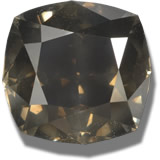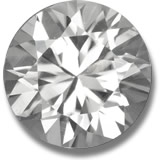Diamond Gemstone Information


About Diamond - History and Introduction
Diamonds have long been regarded as the epitome of luxury, beauty, and enduring strength. Formed under intense pressure deep within the Earth, these precious gemstones are celebrated for their brilliance, hardness, and timeless appeal. Beyond their role in jewelry, diamond gemstones have captivated the human imagination for centuries, symbolizing love, power, and wealth. But there's more to diamonds than their dazzling appearance. With a fascinating history, various types, and numerous uses, diamonds hold a special place in both the geological and metaphysical worlds. Isn't it amazing how something so small can carry such big meaning? Learn about the historic Agra Diamond for a glimpse into their storied past.
Diamond is the transparent, gemstone-quality crystalline form of carbon and it is indeed the hardest-known natural substance on Earth. Diamonds are not only prized for their exceptional hardness, but also for their high refractive index (brilliance) and their remarkably high dispersion rate of visible light (fire). Although traditional colorless or 'white diamonds' are by far the most popular, yellow and brown diamonds (champagne and cognac) are actually the most commonly occurring ones. Other fancy diamond colors include blue, pink, red, green, orange, and black. Red diamonds are one of the rarest gemstones in the world. Unlike most colored gemstones, which get their hue from chemical impurities, red diamonds owe their color to minute defects in the crystal lattice.
The name 'diamond' comes from the Greek word 'adamas,' meaning 'invincible,' which perfectly highlights its superior hardness. The outstanding physical qualities of diamond stem from the strong covalent tetrahedral bonding in its transparent crystals. Each carbon atom connects to four others, packed closely together, creating a strong three-dimensional cubic structure. This cubic pattern is completely symmetrical, allowing diamond to refract light in all directions at the same speed (singly refractive). Discover how diamond and graphite share a carbon bond.
Diamond Formation
Most diamonds form under extreme pressure and very high temperatures, typically at depths over 140 kilometers in Earth's mantle. On average, diamond formation takes 1 to 3.3 billion years. They reach the surface through deep volcanic eruptions of a rare magma called kimberlite. Kimberlite is an ultramafic potassic igneous rock containing minerals like olivine, diopside, calcite, serpentine, garnet, and small amounts of apatite, along with other upper mantle minerals. This magma erupts from rare volcanic vents known as pipes or diatremes. Read about the Lesedi La Rona diamond, one of the largest gem-quality rough diamonds ever found.
Identifying Diamonds
Diamonds can be easily identified through thermal conductivity testing, one of the most common methods jewelers use today to distinguish them from glass. As one of the few singly refractive gemstones, diamonds have a unique carbon-only composition, just like graphite. Diamond is the hardest known substance on Earth (10 on the Mohs scale), with a cutting resistance about 140 times greater than sapphire or ruby (9 on the Mohs scale). It boasts a high refractive index and significant dispersion. Though often imitated, nothing matches its hardness. Experienced gemologists can spot a diamond just by its strong luster - pretty impressive, right?
Diamond Origins and Sources
Approximately half of the world's diamonds come from Central and Southern Africa. Production levels fluctuate yearly, but as of 2023, the top diamond producers include Russia, Botswana, Canada, the Democratic Republic of Congo, and South Africa. Significant deposits have also been found in Angola, Namibia, Australia, India, and Brazil. Canada has emerged as a major commercial source for fine white diamonds in recent years. Explore Sierra Leone's diamond mining history and Botswana's diamond industry for more insights.
Buying Diamonds: Determining Value
Diamond Color
Diamonds are typically known as colorless or 'white,' but yellow and brown are actually the most common colors. These golden and brownish shades come from nitrogen impurities. Brown and yellow diamonds are often called 'champagne' or 'cognac' diamonds. Other colors include pink, red, orange, blue, green, gray, and black. Blue diamonds get their color from boron, while many fancy colors result from irradiation or crystal lattice defects. The color grading for colorless to light-yellow or brown diamonds ranges from 'D' (colorless) to 'Z' (light-yellow). Fancy colors use a different scale altogether. Learn more about champagne diamonds.
Diamond Clarity and Luster
Diamonds show a strong sub-metallic adamantine luster. While they can range from transparent to opaque, only transparent ones are faceted for gems. Most diamonds have too many flaws to be valuable - only about 20% of mined diamonds are gem-quality. Even then, most have tiny inclusions. A flawless diamond? That's incredibly rare.
Clarity grading considers the size and visibility of flaws, from 'FL' (Flawless) to 'I3' (visible inclusions). Though official, clarity grades can vary by evaluator or lab. It's common for one diamond to get different grades from different experts - the same goes for cut and color.
Diamond Cuts and Shapes
The brilliant cut is the most popular for diamonds today, followed by the passion cut, both designed to maximize brilliance and fire through precise faceting. Older styles like modified brilliant, step, and rose cuts are less common now. Round is the top shape, but fancy options include pear, oval, radiant, princess (square), emerald (octagon), asscher, cushion, heart, and trillion (triangular).
Diamond Treatments
Champagne, cognac, and white diamonds are usually untreated but can be enhanced. Laser drilling removes inclusions, glass fills cracks. Many fancy colors are natural, but others come from irradiation or high-pressure/high-temperature treatments. Diamonds are often imitated or lab-grown, though creating synthetics is tough and costly.
Diamond Gemological Properties
| Chemical Formula: | C - Crystallized carbon |
| Crystal Structure: | Cubic (or isometric) |
| Colors: | Colorless, yellow, brown; rarely green, blue, red, orange, gray, black |
| Hardness: | 10 on the Mohs scale |
| Refractive Index: | 2.417 to 2.419 |
| Density: | 3.50 to 3.53 |
| Cleavage: | Perfect |
| Transparency: | Transparent to opaque |
| Double Refraction or Birefringence: | None |
| Luster: | Adamantine - diamond luster |
| Fluorescence: | Variable |
Please refer to our Gemstone Glossary for details of gemology-related terms.
Diamond Varieties and Similar Materials

Diamond is pure carbon, chemically identical to graphite. No other gemstone shares its family, but there are similar stones. Diamonds come in multiple colors, often trading under specific names. Many imitations and simulants exist, but none match the adamantine luster and hardness of natural diamond.
Most Popular Similar or Related Materials and Trade Names:
Cognac diamond, champagne diamond, Canary diamond, fancy diamond, white zircon, graphite, cubic zirconia, moissanite.
Lesser-Known Similar or Related Materials and Trade Names:
Goshenite, danburite, blue diamond, red diamond, black diamond (carbonado), bort diamond, YAG (yttrium aluminum garnet), strontium titanate.
Diamond Mythology and Metaphysical Properties
Historically, diamonds have been said to hold supernatural and metaphysical qualities. Many believe diamonds protect against panic, pestilence, and enchantments. They can amplify thoughts - positive or negative - so if given with love, they foster mutual feelings; if with malice, they might become 'cursed.' Discover the Black Orlov curse for a famous example. Diamonds represent truth and victory, worn to help conquer enemies in battle. Explore diamond symbolism and uses.
Diamonds are thought to aid sleepwalkers and those with mental health issues. As the modern birthstone for April and the 60th anniversary gem, the phrase 'diamonds are forever' stems from beliefs in their power to strengthen relationships. Read about the Koh-i-Noor diamond and the Sancy diamond for their legendary roles in history.
| Disclaimer: Metaphysical and Alternative Crystal Healing Powers and Properties are not to be taken as confirmed advice. Traditional, Ceremonial and Mythological Gemstone Lore is collected from various resources and does not represent the sole opinion of SETT Co., Ltd. This information is not intended to replace the advice of your doctor. Should you have any medical conditions, please see a licensed medical practitioner. GemSelect does not guarantee any claims or statements of healing or astrological birthstone powers and cannot be held liable under any circumstances. |
Diamond in Jewelry Design
Diamonds are the most significant jewelry gemstones today. The diamond market is valued at over $98 billion USD (as of 2024), dwarfing the $20-22 billion for all other colored gemstones combined. For bridal and engagement pieces, diamonds are the top choice. More engagement rings and wedding bands feature diamonds than any other stones. Popular designs also include bracelets, charms, earrings, pendants, and men's accessories. Discover white diamond engagement rings.
Thanks to their brilliance, fire, and hardness, diamonds pair with anything. But remember, they have perfect cleavage, meaning they can split with one blow, like topaz. So, take care when setting, repolishing, or recutting. You'll find diamonds in most local jewelry stores, though quality varies. Many buyers turn online for better deals, but it can make comparing tougher.
Note: Buy colored gemstones by size, not carat weight. Stones vary in size-to-weight ratio - some are larger or smaller than diamonds by weight.
Caring for Your Diamond Jewelry

Diamonds are remarkable gemstones that need minimal upkeep. Wipe them with soapy water and a soft cloth. Ultrasonic cleaners are usually safe, but be cautious with delicate settings. Diamonds resist chemicals, but mountings might not, so skip harsh cleaners for diamond gemstone jewelry.
High heat can etch facets, so avoid extreme temperatures and care when soldering. Store diamonds separately from other gems and jewelry - even other diamonds. Wrap individually in soft cloth or use a fabric-lined box. Remove diamond jewelry before sports, exercise, or heavy chores, and avoid pulling on the stone when taking it off.
Frequently Asked Questions
What is a diamond?
A diamond is the gem-quality crystalline form of carbon, renowned as the hardest natural substance on Earth, prized for its brilliance and fire.
How are diamonds formed?
Diamonds form deep in Earth's mantle under extreme pressure and heat over billions of years, surfacing via volcanic eruptions in kimberlite magma.
What colors do diamonds come in?
Diamonds are often colorless, but commonly yellow or brown. Fancy colors include blue, pink, red, green, orange, and black.
How can I identify a real diamond?
Use thermal conductivity tests, check hardness, refractive index, or consult a gemologist who can spot it by luster alone.
Are diamond treatments common?
Yes, treatments like laser drilling for inclusions, glass filling for cracks, and irradiation for color enhancement are used, though many diamonds are untreated.
What are the metaphysical properties of diamonds?
Diamonds are believed to protect against negative energies, amplify thoughts, and strengthen relationships, but these claims are based on lore and not scientific evidence.
How do I clean diamond jewelry?
Use mild soapy water and a soft cloth; avoid harsh chemicals and extreme heat to protect the setting and stone.

